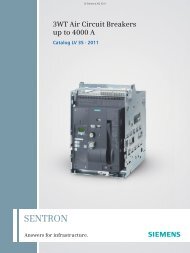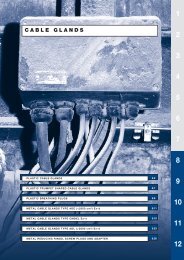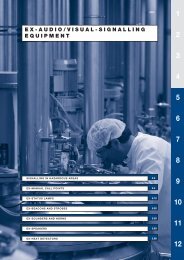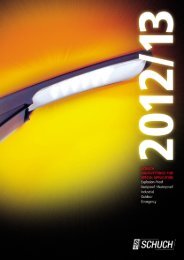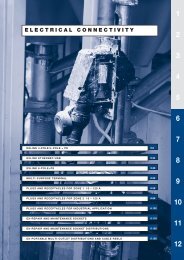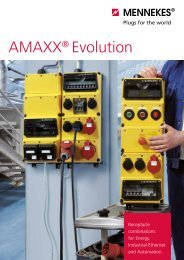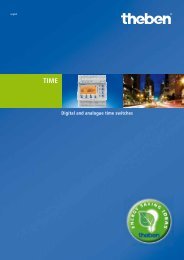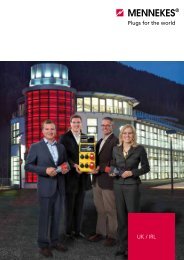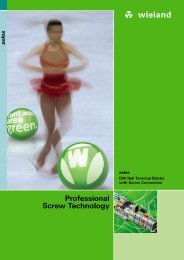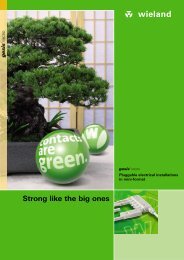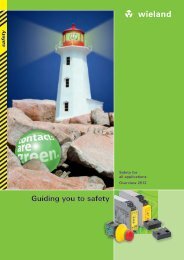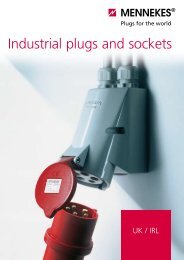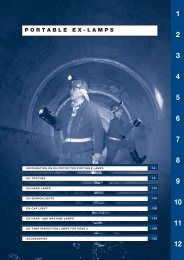DELTA Switches and Socket Outlets Catalog ET D1 · 2011 - Sobel.rs
DELTA Switches and Socket Outlets Catalog ET D1 · 2011 - Sobel.rs
DELTA Switches and Socket Outlets Catalog ET D1 · 2011 - Sobel.rs
You also want an ePaper? Increase the reach of your titles
YUMPU automatically turns print PDFs into web optimized ePapers that Google loves.
© Siemens AG <strong>2011</strong><br />
Technical Information<br />
Communication<br />
General<br />
■ Overview<br />
Data networks<br />
The following three ve<strong>rs</strong>ions are used primarily for the data network:<br />
Ring networks<br />
Star-type networks<br />
Bus networks<br />
I2-6779a<br />
I2-6780a<br />
I2-6781a<br />
Ring networks<br />
In a ring network, the use<strong>rs</strong> (network nodes) are connected in a<br />
closed loop. The data are transmitted from network node to network<br />
node in one direction. To exp<strong>and</strong> the system, simply open<br />
the ring <strong>and</strong> add another user.<br />
Star-type networks<br />
When a star structure is used, all use<strong>rs</strong> are linked to a control<br />
room, which also operates as the system control. It relays the<br />
data to all required devices. This network structure enables multichannel<br />
operation, which supports the simultaneous linking of<br />
many connections. Further use<strong>rs</strong> can be simply connected to<br />
the central operating point if required.<br />
Bus networks<br />
In a bus network, all use<strong>rs</strong> are directly connected to a bus cable.<br />
The data transmitted from one network node are initially received<br />
by all other nodes. However, all the network nodes ignore this<br />
data – with of cou<strong>rs</strong>e the exception of the targeted node. An<br />
expansion of the power supply is achieved by directly tapping<br />
the bus <strong>and</strong> thus connecting new use<strong>rs</strong> to the supply.<br />
Plug-in connecto<strong>rs</strong>, distribution boards <strong>and</strong> outlet boxes<br />
For the connection <strong>and</strong> distribution of cables <strong>and</strong> the connection<br />
of terminals, there are a range of system-specific plug-in connecto<strong>rs</strong>,<br />
distribution boards <strong>and</strong> outlet boxes available.<br />
Flush-mounting devices<br />
These components for data processing <strong>and</strong> data communication,<br />
as well as telecommunication <strong>and</strong> electro-acoustical systems,<br />
are available in the surface-mounting product range of installation<br />
switch/socket outlet systems: <strong>DELTA</strong> line, <strong>DELTA</strong> vita,<br />
<strong>DELTA</strong> miro, <strong>DELTA</strong> profil, <strong>DELTA</strong> style, <strong>DELTA</strong> natur,<br />
<strong>DELTA</strong> fläche, as well as for installation in flush-mounting device<br />
boxes with 60 mm diameter <strong>and</strong> in silltype trunkings with either<br />
vertical or 30° inclined outlets.<br />
Examples<br />
The following describes just a few examples from the great number<br />
of connection components available in the field of data processing<br />
<strong>and</strong> telecommunications technology. Cove<strong>rs</strong> <strong>and</strong><br />
frames (80 mm) in the <strong>DELTA</strong> line, <strong>DELTA</strong> vita, <strong>DELTA</strong> miro,<br />
<strong>DELTA</strong> profil, <strong>DELTA</strong> style, <strong>DELTA</strong> natur, <strong>DELTA</strong> fläche switch/<br />
socket outlets ranges can be used for surface mounting all<br />
sockets.<br />
D-subminiature plug-in connecto<strong>rs</strong><br />
D-subminiature plug-in connecto<strong>rs</strong> are primarily used for the<br />
plug-in connection of computer terminals <strong>and</strong> data transmission<br />
devices, as well as for measuring <strong>and</strong> control equipment. The<br />
outlet box has a 9, 15 or 25-pole trapezoid plug-in pin or socket<br />
connector for connection of one device, or two pin/socket connecto<strong>rs</strong><br />
each, if two devices are to be connected.<br />
BNC/TNC plug-in connecto<strong>rs</strong><br />
BNC 1) /TNC 2) plug-in connecto<strong>rs</strong> are used for high-frequency<br />
applications in coaxial cable networks. The st<strong>and</strong>ard ve<strong>rs</strong>ion is<br />
used for frequencies up to 4 GHz <strong>and</strong> is available for coaxial cable<br />
impedances of 50 W <strong>and</strong> 70 W. For BNC plug-in connecto<strong>rs</strong>,<br />
the connector is linked to the socket of the outlet box over a bayonet<br />
lock <strong>and</strong>, in the case of vibration-resistant TNC plug-in connecto<strong>rs</strong>,<br />
over a screw plug.<br />
Western (WE) plug-in connecto<strong>rs</strong><br />
Western (WE) plug-in connecto<strong>rs</strong> are used in both data processing<br />
technology (e.g. as twisted pair connection 3) ) <strong>and</strong> telecommunications<br />
technology (e.g. as ISDN 4) basic connection).<br />
The WE outlet boxes are equipped with one or two 6 or 8-pole<br />
WE sockets, which, if partially equipped with contacts, provide<br />
4, 6 or 8-pole outlet ve<strong>rs</strong>ions.<br />
Twinax plug-in connecto<strong>rs</strong><br />
Twinax plug-in connecto<strong>rs</strong> are primarily used in local data networks<br />
(LAN) with IBM data terminal equipment. Both primary<br />
conducto<strong>rs</strong> of the Twinax cable are soldered to the Twinax installation<br />
socket of the outlet box, the metal braiding is securely<br />
clamped. After contacting with the outlet box, the connector is<br />
screwed securely into place by a cap nut.<br />
TAE connection units<br />
TAE telecommunication connection units are intended solely for<br />
the connection of telecommunication devices, such as telephones,<br />
fax machines, telex systems. The adapter (connector)<br />
is available on its own <strong>and</strong> preassembled with connecting cable<br />
in various lengths. The outlet boxes with one to three sockets<br />
<strong>and</strong> the adapte<strong>rs</strong> are prepared for telephone connection<br />
(F coding) or for connection of additional devices (fax, etc.) <strong>and</strong><br />
data terminal equipment (Btx) (N coding).<br />
Fiber-optic outlet boxes<br />
Fiber-optic outlet boxes in the <strong>DELTA</strong> profil product range meet<br />
the requirements of a modern cabling system with glass-fiber<br />
cables.<br />
These systems are equipped to cope with future communication<br />
requirements <strong>and</strong> ensure fast <strong>and</strong> reliable transmission for many<br />
applications, such as:<br />
• Telephone (voice, fax),<br />
• Data transmission (client/server, computing, mail, Internet, virtual<br />
LAN),<br />
• Multimedia (integration of voice, data <strong>and</strong> video).<br />
1) BNC: St<strong>and</strong>ard bayonet connector<br />
2) TNC: St<strong>and</strong>ard threaded connector<br />
3) Two twisted cables.<br />
4) ISDN: Integrated Services Digital Network<br />
19<br />
Siemens <strong>ET</strong> <strong>D1</strong> · 10/2010<br />
19/63



